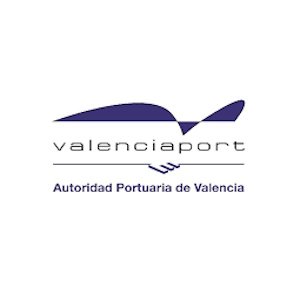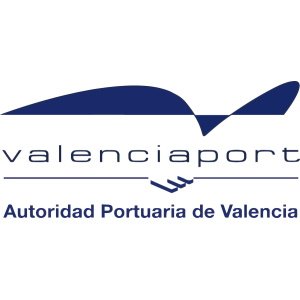Valenciaport (Port of Valencia) - Experts & Thought Leaders
Latest Valenciaport (Port of Valencia) news & announcements
Connectivity, quality, safety and infrastructures. These are the strengths of the Port Authority of Valencia (PAV) in the international fruit and vegetable fair ‘Fruit Attraction’, which is being held at the IFEMA exhibition centre in Madrid from 8 to 10 October. Located in the stand of Puertos del Estado, Valenciaport has attended this event with a sales team led by Cristina Rodríguez, head of containers. Thus, during these three days, the PAV is highlighting its excellent international connectivity through 92 regular services with the whole world and strengthening its commercial relations with customers, suppliers and professionals in temperature-controlled transport and logistics. Traffic of perishable products This is possible thanks to the reefer connections of its terminals: CSP Iberian (Cosco) has 1,500 connections In this sense, the PAV is strengthening – with better facilities, differential services and its commitment to multimodality – the logistics aimed at the traffic of perishable products, an essential sector for many Spanish industries that channel the fruit and vegetables they export to the five continents through the Valencian docks. Every year, an average of around three million tonnes of fish, meat products and fruit and vegetables from all over Spain (fruit, citrus fruits, vegetables, tubers, etc.) enter and leave the Valencian docks. This is possible thanks to the reefer connections of its terminals: CSP Iberian (Cosco) has 1,500 connections, APM (Maersk) has 750 and MSC Terminal another 1,000. Infrastructures provided by the terminal companies, to which must be added the warehouse of the Agro Merchants Group company – which has 16,000 square metres destined exclusively for the logistics of refrigerated products –, the 17,000 square metre Border Control Post (PCF) which, through the Guarantee Mark, guarantees that any container taken to these facilities must be checked in less than 45 minutes and the Border Control Post of the Port of Sagunto; all of these facilities have growing demands.
Valenciaport is a strategic enclave that facilitates trade for the Spanish economy and for exporting companies and, specifically, for companies involved in the wine trade that reach the five continents through the docks of Valenciaport. Spanish wine In fact, according to data from the Port Authority of Valencia (PAV), the wine produced in Spain and which leaves through the Valencian docks maintains trade relations with 132 countries. Thus, in the last six months, 1,032,959 tonnes of wine have been handled from Valenciaport with destinations in America, Africa, Asia, Oceania, and Europe. Maritime connectivity Maritime connectivity allows greater participation in international trade and better access to markets The PAV maintains connections with almost 1,000 ports in 168 different countries around the world. In this sense, maritime connectivity allows greater participation in international trade and better access to markets and, therefore, Valenciaport is a strategic enclave for Spanish exporting companies. Italy leads in wine imports Italy is the country that buys the most Spanish wine: in 2024 it absorbed 29.2% of total traffic with 301,457 tonnes imported. Europe is the continent that buys the most wine from Spain, specifically 53.74% of the total exported. Thus, countries such as Greece, the Netherlands, Denmark, Belgium, Slovenia, France, Romania, and Germany have a large demand for the highly appreciated Spanish wine. Wine purchases in other continents The second position is occupied by the American continent, specifically, the United States alone buys 58,521 tonnes of wine through Valenciaport. A global vision shows that the American continent is an excellent buyer of Spanish wine that reaches places such as Argentina, Venezuela, Guatemala, Honduras, Peru, Puerto Rico, Panama, Ecuador, Colombia, and Chile. For their part, Asian countries occupy third place in the ranking of continents, with China and Japan being the largest exporters with 80,656 and 48,084 tonnes respectively. High demand in Australia The Valencian docks are one of the main suppliers, as 4,501 tonnes have been imported Australia has an undisputed role in the global wine import market, with more than 33.5 million litres imported from all corners of the world in 2022. According to ICEX Spain Export and Investment, the Iberian Peninsula is in sixth place in terms of import volume. In this sense, the Valencian docks are one of the main suppliers, as 4,501 tonnes have been imported so far in 2024 from Valenciaport alone. Imports increased in New Zealand Wine imports into New Zealand and Australia have been increasing in recent years, except for 2020, when a drop was recorded because of the COVID-19 health crisis. According to figures recorded by Valenciaport in the first six months of 2024, New Zealand has already imported more than 1,000 tonnes.
The last of the 18 ‘Training of Trainers’ workshops given by the United Nations Conference on Trade and Development (UNCTAD) since 2008, the year of the creation of the Spanish-speaking Network for the port training programme, closed on July 12, 2024, at Valenciaport. In these 16 years, more than 260 instructors have participated, 72 of them women, to be trained in the key management skills of port management. ‘Train For Trade’ programme Twenty-one students of seven Latin American nationalities participated in this latest edition hosted by Valenciaport, who received more than seventy hours of training during twelve days. The course hosted by the Port of València is part of the ‘Train For Trade’ programme, organised by UNCTAD. Under the name ‘Training of Trainers Workshop, a course on modern port management’, its content -developed by experts from Valenciaport and the port community of València- has focused on teaching the key directives of port management divided into four modules. Relevance of port training Mar Chao, president of the Port Authority of València; Mauricio Cruz Reyes, representative of Mexico to the IMO (International Maritime Organisation); Francisco Trujillo, general director of the Port Authority of Las Palmas; Jesus Requena, deputy director of Human Resources and General Services at Puertos del Estado; Clara La Calle, general secretary of Puertos del Estado; and Mark Assaf, head of the Human Resources Development section / TrainForTrade of the UNTACD have closed the workshop. Chao stressed during his closing speech the relevance of port training because “training is essential to better read the challenges that customers demand from us because outside the fence – as I always say – things go very fast. You must know everything that is ‘coming’ to get the course right and reduce management times and that can only be achieved with training. And sharing that training with all the ports will result in a better future for everyone.”

















